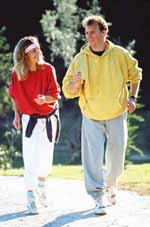






Like walking, jogging can be done anytime, anywhere, and involves only one person: you. Jogging has all the health benefits of walking- it conditions the heart, improves muscle tone and strength, relieves stres, and can help with a variety of health problems, such as osteoporosis, heart disease, and arthiritis. While walking may conjure al the pleasures of a casual stroll, jogging requires more of a commitment to training and results. It takes discipline to run, but the rewards are measurable improvements in time, distance, endurance and strength.
The number of calories you burn when jogging will vary with the intensity and duration of your workout. According to the American Council on Excercise (ACE), a 160- pound person will burn about 12.5 calories for each minute of activity. Heavier individuals will burn more calories for the same amount of excercise while a ligher individual will burn less.

The big advantage of jogging over walking is that it takes less time, is the most efficient way to achieve cardiovascular fitness, and depending on your distance will burn more calories. The disadvantages is that it can result in more injuries, as the strain placed on both muscles and joints is greater. But with proper shoes and preparation through stretching, you can greatly reduce your risk of injury.
If you are older, overweight, or have health problems, you may want to get at check-up from a physician before you begin to run, or do any strenuous excercise. If you have never excercised before, begin with brisk walks, jumping jacks, and jogging in place to test your endurance.
Warm up first with some light stretching, followed by either a fast walk or a slow run. Gradually build up to a pace that's comfortable for you.
Most experts suggest that you land on the ball of your heel, and let the rest of the foot follow. You want to push off your toes as you begin your next step.
Don't hunch up. Keep your back reasonalby straight, your shoulders back. When you come to a hill, it is only natural to lean forward a bit, which is perfectly fine.
Let your arms swing naturally, don't hold them to your sides.
Don't worry so much about how far you are jogging. Rather thatn a set a distance goal, set a time goal. Increase your time gradually; experts usually recommend an increase of only 10% a week to avoid injury from over-exertion.
Bring some cool water along, to keep your body from becoming dehydrated from your workout.
Any pair of comfortable shoes will, but don't wear thin, dress socks. If you get blisters, put some vaseline on your feet and switch to running socks.
Then begin with five minutes of slow to brisk walking.
Do 15-30 minutes of jogging, with walking breaks if you need it.
Cool down with with some brisk to slow walking.
When you reach home, do some leg strethches, as well as the posture stretches mentioned in the stretching section.
You should wait at least 3 hours after jogging, before doing any passive or active stretches, to give your bones a chance to relax.
